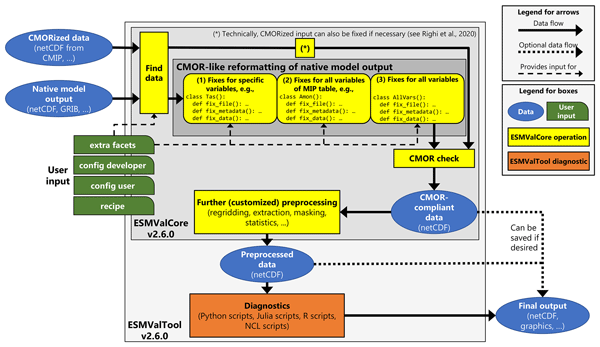New evaluation paper including EMAC

The publication “Evaluation of native Earth system model output with ESMValTool v2.6.0” by M. Schlund et al. is now available at EGU’s open access journal “Geoscientific Model Development”. The authors apply the latest version of the ESMValTool to evaluate output of different Earth system models including EMAC. They present a new extension to the ESMValTool, which allows reading and processing native output of these Earth system models, performing a CMOR-like reformatting of output from the different numerical models during runtime.
https://doi.org/10.5194/gmd-16-315-2023
Abstract: Earth system models (ESMs) are state-of-the-art climate models that allow numerical simulations of the past, present-day, and future climate. To extend our understanding of the Earth system and improve climate change projections, the complexity of ESMs heavily increased over the last decades. As a consequence, the amount and volume of data provided by ESMs has increased considerably. Innovative tools for a comprehensive model evaluation and analysis are required to assess the performance of these increasingly complex ESMs against observations or reanalyses. One of these tools is the Earth System Model Evaluation Tool (ESMValTool), a community diagnostic and performance metrics tool for the evaluation of ESMs. Input data for ESMValTool needs to be formatted according to the CMOR (Climate Model Output Rewriter) standard, a process that is usually referred to as “CMORization”. While this is a quasi-standard for large model intercomparison projects like the Coupled Model Intercomparison Project (CMIP), this complicates the application of ESMValTool to non-CMOR-compliant climate model output.
In this paper, we describe an extension of ESMValTool introduced in v2.6.0 that allows seamless reading and processing of “native” climate model output, i.e., operational output produced by running the climate model through the standard workflow of the corresponding modeling institute. This is achieved by an extension of ESMValTool’s preprocessing pipeline that performs a CMOR-like reformatting of the native model output during runtime. Thus, the rich collection of diagnostics provided by ESMValTool is now fully available for these models. For models that use unstructured grids, a further preprocessing step required to apply many common diagnostics is regridding to a regular latitude–longitude grid. Extensions to ESMValTool’s regridding functions described here allow for more flexible interpolation schemes that can be used on unstructured grids. Currently, ESMValTool supports nearest-neighbor, bilinear, and first-order conservative regridding from unstructured grids to regular grids.
Example applications of this new native model support are the evaluation of new model setups against predecessor versions, assessing of the performance of different simulations against observations, CMORization of native model data for contributions to model intercomparison projects, and monitoring of running climate model simulations. For the latter, new general-purpose diagnostics have been added to ESMValTool that are able to plot a wide range of variable types. Currently, five climate models are supported: CESM2 (experimental; at the moment, only surface variables are available), EC-Earth3, EMAC, ICON, and IPSL-CM6. As the framework for the CMOR-like reformatting of native model output described here is implemented in a general way, support for other climate models can be easily added.
© Author(s) 2023. This work is distributed under the Creative Commons Attribution 4.0 License.
Schlund, M., Hassler, B., Lauer, A., Andela, B., Jöckel, P., Kazeroni, R., Loosveldt Tomas, S., Medeiros, B., Predoi, V., Sénési, S., Servonnat, J., Stacke, T., Vegas-Regidor, J., Zimmermann, K., and Eyring, V.: Evaluation of native Earth system model output with ESMValTool v2.6.0, Geosci. Model Dev., 16, 315–333, https://doi.org/10.5194/gmd-16-315-2023, 2023.
